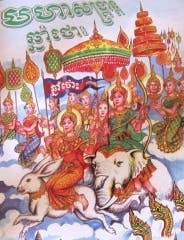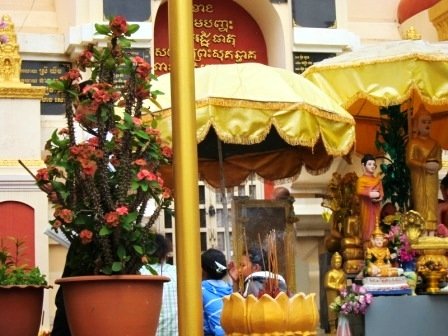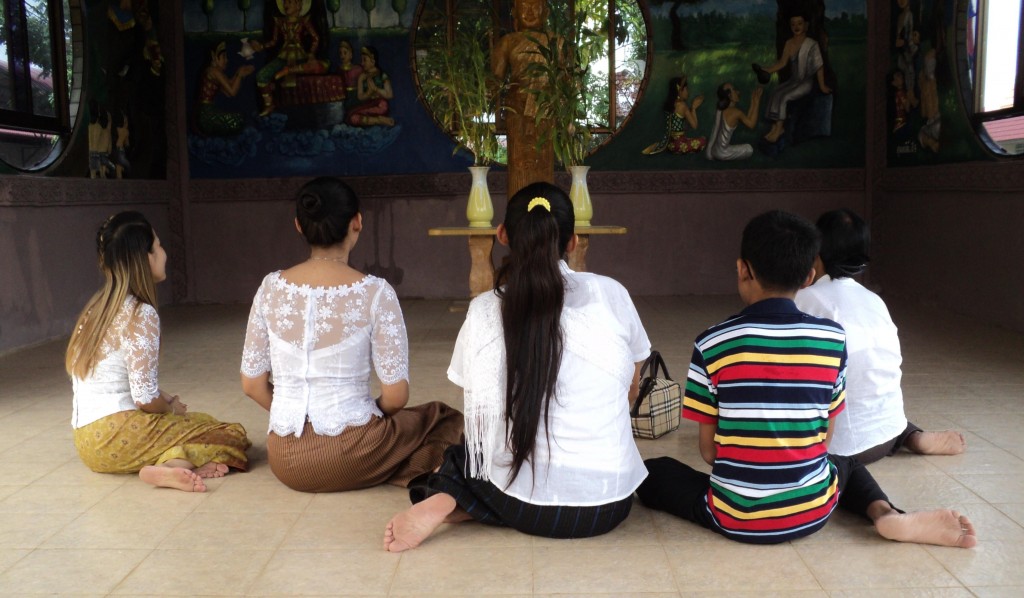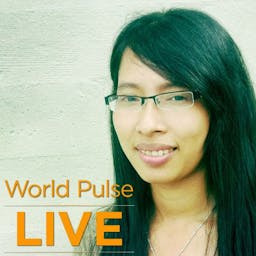Cambodia, Khmer Traditional New Year (April 14-16 2011)
Jan 21, 2015
Story




The History of Khmer New Year (Cambodia Traditional New Year)
The celebration of the Khmer New Year has a very interesting legend. You will notice that in the picture of the New Year Angel, she comes carrying a jeung bian (golden tray) with the king of the gods' head. The story goes that once there was a very smart boy called Dhomabal Khumar, born to a very wealthy family. Dhomabal was exceptional in that he spoke four languages, read at 7 years of age the ancient texts and canonical scriptures that monks study and spoke to the birds.
The village people loved him as he was not only clever but also kind. His father built him a beautiful temple close to the river where the birds lived and there Dhomabal would speak to the birds. But then, the king of the gods, KabilMohaProm, became jealous of Dhomabal and issued a challenge. He told Dhomabal that if he could not answer the questions he posed to him, he would cut his head off. But, if he could answer it, KabilMohaProm will cut off his own head. The questions:Where do you find happiness in the morning? The Noontime? And, in the evening?
As Dhomabal did not know the answer, he run away to the forest. Fearing for his life, he slumped into a tree where two eagles were perched in a conversation. Dhomabal heard them talking about the question on happiness to which they gave the answer. So Dhomabal learned the answers: in the morning, you find happiness in your face; midday, you find it in your body, and at night, your feet. Dhomabal gave the god the answer and he went to the king of the gods and gave him the answer. Because it was correct, the king of the gods had his own head cut off. He then told his eldest daughter to put his head in a jeung pian and carrying this golden tray circle around the Sumeru mountain for 60minutes and then bring his head to the Khimalay temple in heaven. His head cannot be thrown to the ground as this will cause fire, to the the sky as this will cause drought or to the ocean as this will dry up so the seven daughters have to take turns carrying the head. From then on, as the king of the gods cannot anymore bless his people, he sent his seven daughters as his angels to give his Khmer people blessing at the start of the new year.
Because of the story of Dhomabal, to get the blessing for the new year, the Khmer follow the ritual of washing their face in the morning, their body in midday and their feet in the evening.
Khmer New Year: A Three Day Celebration
The celebration is for 3 days, three considered to be an auspicious number by Khmer. Each day has a distinct name to express the ritual being followed: the first day being Maha Songkran, the second day Virak Wanabat and the third, Thngay Leang Saka. Each one takes energy and family team activity, like ramping up to Christmas.
Days before the Chaul Chnam Thmey, Cambodians get busy. They clean the house, every corner of it. The angel may check! They prepare special food and buy new clothes. Even the husband gets a polishing and grandma a decent dusting at least. Everything has to be spic and span for the visit of the New Year Angel and with the kids, you've got it, she knows who has been naughty or nice.
The new year celebration engages everyone in Cambodia. In fact, the frenzy has already started. Preparations are already discussed in the family. Everyone is expected to be home to welcome the new year angel and go with the family to the temple. Special delicacies will be prepared especially the sticky rice with meat, eggs and bananas. Trips are arranged. Ancestor graves cleaned up.
Moha Songkran, this is the first day of the celebration. This marks the end of the year and the beginning of a new one. People wake up early, primp up in their new finery, light candles and burn incense sticks in the house shrines to the family spirits. The special table is ready to welcome the new angel with fresh fruits, flowers and all the other things required. Members of each family do the needful and offer thanks to Buddha. As the small prayer houses are often by the front steps of the houses or the entrance to the small businesses, you can see whole families bowing, kneeling and prostrating themselves three times before Bhudda's image.
Moreover, for good luck, the Khmer also wash their face with holy water in the morning, their bodies at noon, and their feet in the evening before they go to bed. The rituals are observed by most Cambodians, not just the village folk and missing the moment is like stepping on superman's cape. The angel is secretly watching!
Virak Wanabat is the name of the second day of the new year celebration. People contribute charity to the less fortunate by helping the poor, servants, homeless, and low-income families. Families attend a dedication ceremony to their ancestors at the monastery.
Tngay Leang Saka is the name of the third day of the new year celebration. Buddhists cleanse the Buddha statues and their elders with perfumed water. Bathing the Buddha images is the symbol that water will be needed for all kinds of plants and lives. It is also thought to be a kind deed that will bring longevity, good luck, happiness and prosperity in life. By bathing their grandparents and parents, children can obtain from them best wishes and good advice for the future.
Also, during the Khmer New Year Festival, youths gather to play popular traditional games such as Chaol Chhoung (throwing a ball) and Bas Angkunh (throwing brown seeds). The youths are normally divided into female and male teams to play these games.
2011 Khmer New Year:
This year's Khmer New Year angel is the fifth youngest in the family of seven and her name is KarineyTevi. She'll come riding on an elephant joined by a cast of thousands of angels. At the lead of the procession is the guide angel riding a rabbit, this being the year of the rabbit and therefore her knowing the way.
This year's angel, KarineyTevi, on the cover of the book, Maha Songkran, published each year to guide the Khmer on how to celebrate this new year. The offerings are clearly stated there and the time when the angel arrives. It looks like the she'll come between 11-12 noon on the 14th of April, a Thursday.
The coming of the angel will be announced by drums and gongs in the temples. At home, the Khmer watch the television to wait for the signal that the angel has come. It's the same guys that do the Santa radar watch. Once the signal has been aired, the family gathers around the table prepared specially for this occasion and pray to the angel to give them the blessing.
The Khmer believe that the families that prepare well to welcome the New Year Angel, will get what they pray for. In fact, astrologers are employed to determine what the angels love. It turns out that for 2010, the New Year Angel wanted fresh milk and red juice.
This year, 2011, 1 pair of numva banana, a pair of coconuts, 11 items of fruits and sweets are what the angels want. So, get ready and let the Khmer new year angel find you worthy.
Happy Khmer New Year - to all people who have read this article - Susdei Chnam Thmei. May the New Year Angel bring you and your family prosperity, joy and peace.
Sources:
http://en.wikipedia.org/wiki/Cambodian_New_Year
http://cambosastra.wordpress.com/2009/04/10/the-history-of-khmer-new-year/
Maha Songkran Book, published in 2010 for year of Rabbit




